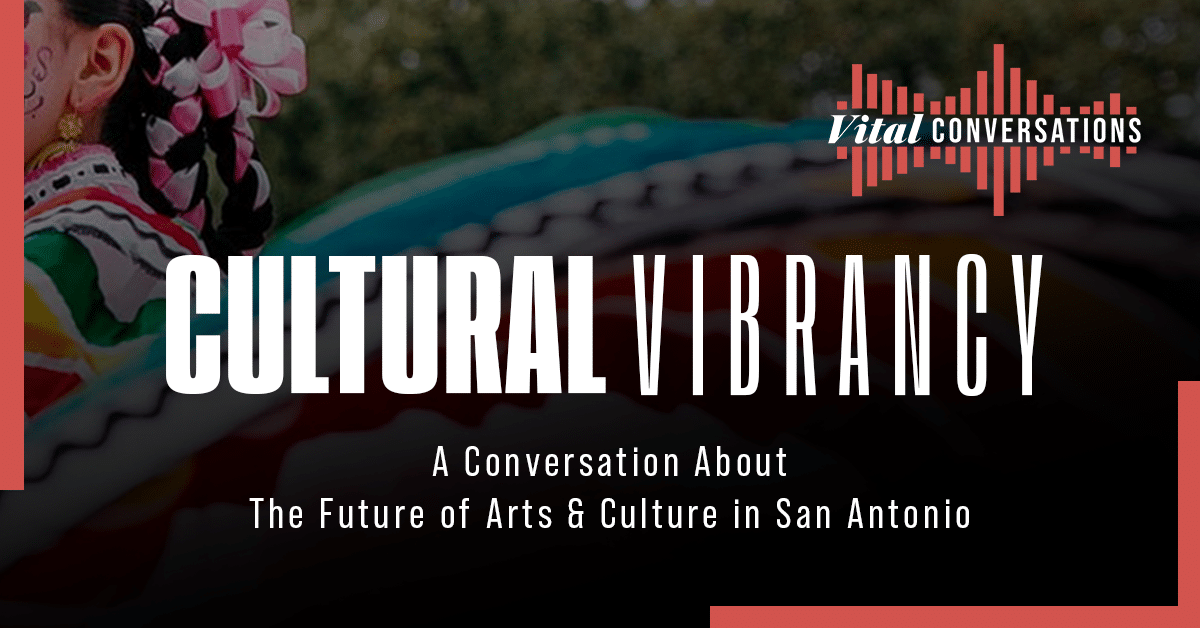
If you’re familiar with our mission and work, you likely know that we work with generous donors to help fund hundreds of wonderful nonprofit organizations across our community. What you may not have heard about are our dedicated and passionate staff members within our Community Engagement and Impact (CEI) team who work with those organizations in getting the financial backing they need to continue doing great work.

That’s why we’re launching a series of multi-media informational packages featuring our CEI Program Officers. First up is Stephanie LaFroscia, Senior Program Officer for Cultural Vibrancy, our major impact area focusing on arts and culture. Stephanie holds the arts community close to her heart – and her work experience aptly reflects it.
She has worked with cultural organizations for more than a decade, including Artpace and Luminaria Contemporary Arts Festival at the local level. Stephanie’s previous stops were in the Big Apple, where she worked at the New York City Department of Cultural Affairs following her previous post at El Museo del Barrio. She completed her Bachelor’s degree in Art History at Trinity University in San Antonio and then went on to receive a Master’s degree in Visual Arts Administration from New York University. She currently lives in San Antonio with her wife and children.
Stephanie has been the Area Foundation’s lead in working with Texas Public Radio (TPR) as part of our “Vital Conversations” collaborative project. This third in a series of four broadcast and digital discussions focuses on Cultural Vibrancy. Stephanie will be a speaker on a live online panel discussion this Friday (Jan. 29) from 2 p.m. to 3 p.m. Register for this free event here. Please continue reading for an in-depth discussion with Stephanie about her work here at the Area Foundation and make sure to check out the accompanying video to hear more about what Cultural Vibrancy is all about.
You’re part of the Area Foundation’s Community Engagement and Impact (CEI) team. What is the principal mission of this team and what’s your particular role in it?
The CEI team is the two-way bridge connecting our donors and the mission-driven work of the people and organizations serving communities in San Antonio. As a team, CEI is in constant conversation about the overlap of challenges and support between our four major grantmaking impact areas. Our nonprofit partners don’t work in isolation and arts in particular intersect with programs for mental health, active aging, youth leadership and education, public health advocacy and equitable community development, so I’m always learning from my colleagues and artists working in these fields. As the program officer for Cultural Vibrancy, my role is to collaborate with nonprofits, to see and participate in the work they are doing and to understand the local and national landscape. I am an advocate for artists and cultural organizations within the Area Foundation and externally with our community partners.
You seem quite passionate about the arts. What’s so important about the arts in our community and do you believe nonprofits working in this sector are sufficiently supported?
San Antonio has a wealth of artists and audiences to support a wide range of art forms and cultural traditions. The challenge for San Antonio is that we don’t have as wide of a range of philanthropic support for the arts as we might see in other larger cities in Texas. We rely on local governmental support and a closely connected and deeply committed community of institutional, corporate and individual supporters. We will need to broaden that circle of supporters in order to sustain the arts and cultural preservation at a level that San Antonio deserves.
Why is it particularly important and relevant for the Area Foundation to supports the arts community?
The Area Foundation has the enviable role of supporting traditional and contemporary artistic expressions and artists working across and between disciplines, in both rural and urban communities — our house is expansive. Culture has shaped the identity of our region and remains central to our growth as a dynamic city. Visitors come to San Antonio because of our reputation as city with a rich cultural heritage and they stay because of the access to diverse cultural experiences supported by dedicated writers, actors, musicians, filmmakers, dancers and visual artists. If we are to maintain that special sauce that makes San Antonio and surrounding communities unique, we have to support the continuation of traditional arts and preserve the history of San Antonio neighborhoods. At the same time, we need to ensure that artists and cultural organizations have the resources and freedom to imagine futures not yet seen and create new works that play with and challenge convention.
How would you describe the impact that the coronavirus pandemic has had on nonprofits?
During the pandemic, arts organizations and cultural workers have remained committed to maintaining connections with students, artists and audiences, despite circumstances that devastated traditional revenue models and upended programming. Nonprofit arts organizations lost the ability to welcome school groups into museums, canceled fundraising events and closed theater doors. Many of our cultural organizations are centered in African-American and Latinx communities deeply affected by dual health and economic crises, straining their capacity to confront the trauma both personally and with the cultural communities they serve. Yet within weeks of closures across the city last spring, we saw organizations sharing resources and learning from each other as they adapted programming to online platforms and invested in remote arts education opportunities for their students.
Surely you must come across very interesting and talented people in the arts community. Can you share a story about a person or group you’ve met that left a lasting impact on you?
The International Accordion Festival, which last took place in 2015, remains one of my favorite events. I am fascinated by the accordion and its inescapable sound — an instrument sustained by migrant cultures because of its portability and still present in traditional music from Central Asia to Louisiana and of course here in South Texas. There are so many opportunities to appreciate the versatility and emotion inherent in the accordion — from San Antonio-based band Piñata Protest showcasing the accordion alongside punk rhythms, to the Guadalupe Cultural Arts Center celebrating regional traditions in their annual Tejano Conjunto Festival and Conjunto Heritage Taller where master musicians teach the next generation.
Clicl here to learn more about how the San Antonio Area Foundation aims to preserve San Antonio’s rich culture and history and enhance community connectivity through the arts by focusing in one of our impact areas, Cultural Vibrancy.


Our hearts are with the Kerrville community following the devastating flooding.
Please consider making a donation to help our neighbors rebuild by clicking here.